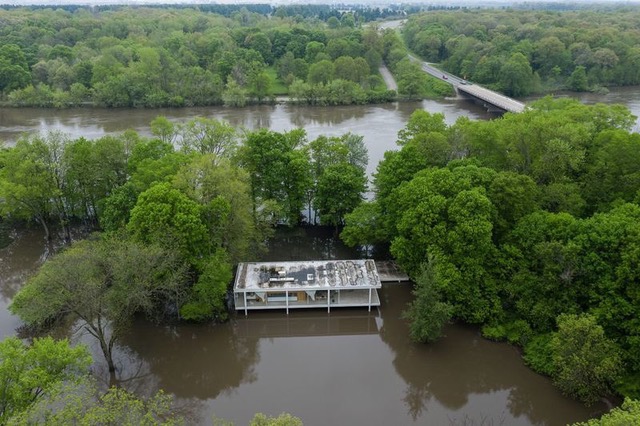Blair Kamin, the architecture critic of the Chicago Tribune, recently tweeted a May 19 photograph of Mies van der Rohe’s famous Farnsworth House almost inundated by the rising waters of the nearby Fox River. Kamin writes that the water level appears to be receding, so it seems likely that the house may be spared, at least this year. Although its floor is raised five feet in the air, because Mies sited the house on low ground only 75 feet from a river that regularly overflows its banks in the spring, the house has been flooded several times, the first as early as 1954, only three years after it was built. A 1996 flood brought several feet of water into the house and blew out a window. One solution, because the house is basically a (glass) box on stilts, would be to move the whole thing to higher ground on the property. Instead, the National Trust for Historic Preservation, the current owner, is considering installing hydraulic jacks that will raise the house whenever the river floods. The rationale for this contraption, is that changing the location of the house would compromise the architect’s vision. The truth is that Mies designed the same steel and glass boxes irrespective of their setting and location—urban or rural, Montreal or Mexico City. “It’s ridiculous to claim that the house’s siting is essential to its authenticity, especially given Mies’s basic approach to universality,” says my Penn colleague David De Long, an architect and experienced preservationist who has consulted on the conservation of several Frank Lloyd Wright houses, including Auldbrass in South Carolina. “Wright’s houses, which were more specifically designed for a specific site, have been successfully moved without major compromise,” he points out.



If such a site-specific historic landmark as the Cape Hatteras light can be moved over half a mile, I think it’s probably safe to move one of Mies’s generic boxes a hundred meters to keep from flooding its virtual basement.
Oddly, if you didn’t know the history of the house you might assume from the photo that it was always sited in the middle of the river. It’s just missing a sleek aluminum rowboat tied alongside. Or maybe it could meet its logical conclusion by having a couple pontoons added underneath and becoming yet another boxy houseboat.